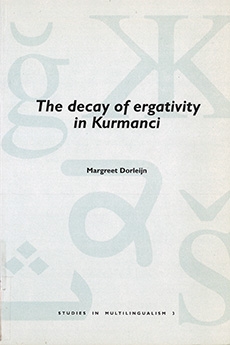|
ACKNOWLEDGEMENTS
I wish to thank a number of people and institutions that have contributed to this study.
The University of Amsterdam and the Netherlands Organisation for Scientific Research (NWO) have provided financial support that made a fieldwork trip to Turkish Kurdistan possible. The Faculty of Arts of the University of, Amsterdam moreover granted me a one-trimester sabbatical.
I am greatly indebted to my supervisor, Pieter Muysken, for his inspiration and encouragement and for his patience with my idiosyncratic way of working.
To Rik Boeschoten, Reineke Bok-Bennema, Joris Croon, Michiel Leezenberg, Yaron Matras, Francine Swets and Amoud Vrolijk I am grateful for valuable discussions and comments on earlier versions of this study.
Hans Broekhuis and Joop Veld have patiently tried to familiarize me with all sorts of Government and Binding Theory intricacies. I thank them both.
I have profited greatly from Ab de Jongs knowledge of Old and Middle Iranian.
I am very much indebted to Joris Croon, Rahime Henden, Zeynel Abidin Kizilyaprak, Michiel Leezenberg and in particular Sadik Ziypak for their help in collecting the speech data. Martin van Bruinessen gave me disposal over Kurmanci speech samples which he had collected earlier.
Frans Janssen has drawn the maps in this book, the first one of which has appeared earlier in Martin van Bruinessen’s Agha, Shaikh and State (1992), and appears here with the kind permission of the author. The second map was drawn for this book, and on very short notice indeed. I am greatly indebted for that.
The tedious and difficult task of transcribing the spontaneous speech data was made much lighter through the help of Halid and Ferat (who may not care to have their family name mentioned) and Joris Croon.
Most of all, I am indebted to the people that provided the speech data. Sadik Ziypak is one of them. The others prefer to remain anonymous. At times some risk was involved in co-operating in the data collection sessions, but the fact that their language was the object of scientific study induced people to take that risk, even though most of them would question the actual benefit of such a study. I hope they are not disappointed by the result.
Finally, I thank Amoud, Steven and Alexandra Vrolijk for supporting me and distracting me, respectively, and for complying with quite a few wifeless or motherless Sunday afternoons.
Chapter 1: Introduction
This study tries to give an impression of the influence of Turkish on the Kurmanci dialect of Kurdish. More in particular, it intends to offer a treatment of split ergativity in Kurmanci. The aim is to show, on the basis of emerging patterns of variation, how varieties of Kurmanci are on the way to becoming nominative/accusative altogether. One of the main findings is that, besides internal tendencies, contact with Turkish may be a determining factor in this process.
Kurmanci is spoken by approximately 12 million people living mainly within the boundaries of the Turkish Republic. Turks and Kurds have a long history of (not always peaceful) coexistence, and many Kurds are bilingual in Turkish and Kurdish.
The linguistic effects of contact with Turkish on Kurmanci have, to my knowledge, not yet been the subject of extensive and systematic research. Two studies on Turkish-Kurdish language contact are Bakaev (1977) and (of much smaller scope) Zajaczkowski (1983). These studies are concerned mainly with the borrowing of Turkish content words into Kurdish. Biasing (1995) offers a treatment of the borrowing of Kurdish lexical items in Turkish. Bulut (forthc.) and Dorleijn (1996 and forthc.) include some observations on borrowed Turkish function words and bound morphemes in Kurmanci and also, in a cursory fashion, a description of some morpho-syntactic phenomena in Kurmanci that may be attributed to language-contact.
The study of Turkish-Kurdish language-contact is interesting in more than one respect. Firsdy, Turkish in contact has, at least from a morpho-syntactic point of view, mainly been studied in (older or newer) immigrant situations (see, e.g., Johanson, 1992 and references there), where Turkish is the language of the immigrant community. In these situations Turkish is dominated by another language, mosdy an Indo-European language, and receives elements from this language through borrowing (or copying, in the terminology of Johanson, 1992). In Turkish-Kurdish language contact the situation is almost the reverse: Turkish is the dominant language, in particular since the advent of the Turkish Republic with its stem Turkification policies.
Kurdish, an Indo-European language, is the receiving party. The situation is not entirely the reverse, obviously, for neither the Turkish, nor the Kurdish community can be considered an immigrant community.
Secondly, the two languages involved are not only genetically but also typologically highly distinct. Turkish is, for example, transparent from a morphological point of view. The syntactic function of each element is …
| 